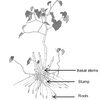Today’s fact of the day will be rather simple, and more focused on the physical aspects of kava. I know we’ve delved into quite some depth lately, so this is a simple one with a little science peppered in.
Kava is broken down into its usable parts after harvesting. These parts are known as “kasa” or basal stems, stump also known as “corm” or lewena, and the lateral roots that run horizontally along the ground.
These individual parts each have differing concentrations of kavalactones contained within. A study was performed to quantify the levels of kavalactones in each separate part of the plant. This can be thought of as a generality as kava’s kavalactone percentages range between plants, and is never a standard number.
If we start with the roots as being the strongest part of the plant by kavalactone content we can see that the stump or what’s known as Lewena contains about 75% of the kavalactones as the lateral roots. Moving up the plant, the basal stems have about 25-40% the amount of kavalactones than are found in the lateral roots.
When you purchase kava, you’re presented with several types to select from. The term “waka” is used to describe the lateral roots only, where lewena is the corm only. The word “kasa” or stems is not something you’ll usually see advertised in a kava product listing. Kasa has the lowest amount of kavalactones and are usually added as a filler by vendors looking to increase weight. If your kava doesn’t say waka or Lewena, it’s going to be a mix of some ratio of lateral roots to corm percentage. The more common mix we see is 80% lewena, and 20% lateral roots (80/20) in Vanuatu, and 60/40 - 70/30 mixes in powders from Fiji. This essentially captures the natural kavalactone percentage of the plant, while providing a smoother taste that isn’t as bitter as waka.
Lewena has received less attention due to thought that lower kavalactone % will equal a lesser experience. This isn’t necessarily the case, as some kavalactones are almost in the same concentrations as the roots. Some of these lewena kavas have tests coming back from 6-8% kavalactones which consequently is the same percentage as some of my favorite kavas. If you haven’t given lewena a shot, I suggest it. It’s the milder, more pleasant tasting version of waka that still packs a punch.
Lebot, V., Kaoh, J. & Legendre, L. High-Throughput Analysis of Flavokawains in Kava (Piper methysticum Forst. f.) Roots, Chips and Powders and Correlations with Their Acetonic Extracts Absorbance. Food Anal. Methods 13, 1583–1593 (2020). https://doi.org/10.1007/s12161-020-01781-9
Kava is broken down into its usable parts after harvesting. These parts are known as “kasa” or basal stems, stump also known as “corm” or lewena, and the lateral roots that run horizontally along the ground.
These individual parts each have differing concentrations of kavalactones contained within. A study was performed to quantify the levels of kavalactones in each separate part of the plant. This can be thought of as a generality as kava’s kavalactone percentages range between plants, and is never a standard number.
If we start with the roots as being the strongest part of the plant by kavalactone content we can see that the stump or what’s known as Lewena contains about 75% of the kavalactones as the lateral roots. Moving up the plant, the basal stems have about 25-40% the amount of kavalactones than are found in the lateral roots.
When you purchase kava, you’re presented with several types to select from. The term “waka” is used to describe the lateral roots only, where lewena is the corm only. The word “kasa” or stems is not something you’ll usually see advertised in a kava product listing. Kasa has the lowest amount of kavalactones and are usually added as a filler by vendors looking to increase weight. If your kava doesn’t say waka or Lewena, it’s going to be a mix of some ratio of lateral roots to corm percentage. The more common mix we see is 80% lewena, and 20% lateral roots (80/20) in Vanuatu, and 60/40 - 70/30 mixes in powders from Fiji. This essentially captures the natural kavalactone percentage of the plant, while providing a smoother taste that isn’t as bitter as waka.
Lewena has received less attention due to thought that lower kavalactone % will equal a lesser experience. This isn’t necessarily the case, as some kavalactones are almost in the same concentrations as the roots. Some of these lewena kavas have tests coming back from 6-8% kavalactones which consequently is the same percentage as some of my favorite kavas. If you haven’t given lewena a shot, I suggest it. It’s the milder, more pleasant tasting version of waka that still packs a punch.
Lebot, V., Kaoh, J. & Legendre, L. High-Throughput Analysis of Flavokawains in Kava (Piper methysticum Forst. f.) Roots, Chips and Powders and Correlations with Their Acetonic Extracts Absorbance. Food Anal. Methods 13, 1583–1593 (2020). https://doi.org/10.1007/s12161-020-01781-9


